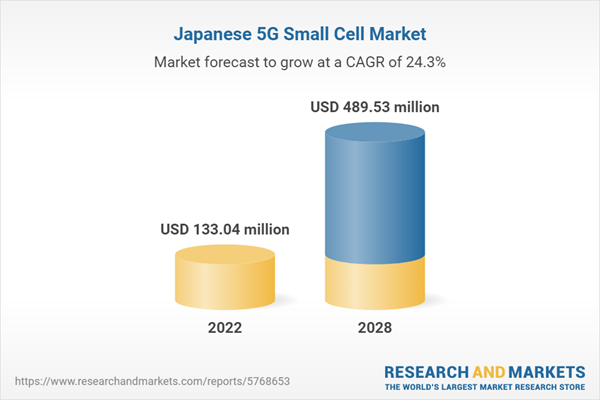Indoor Deployments
According to Nokia, indoor mobile users account for around 80% of mobile broadband traffic. Indoor small cells are considered an essential deployment option as providing adequate indoor coverage can also be difficult, particularly because the higher frequencies employed by 5G are more exposed to signal propagation limits than earlier generations of mobile technology.The launch of 5G technology in Japan has enabled an increased indoor deployment of the technology. For instance, the concept of a smart stadium has utilized advanced technologies to create new viewing experiences for sports.
Furthermore, in December 2020, Rakuten conducted a 5G trial to create a “smart stadium” with the help of drones and live streaming of 360-degree VR video. It was Japan’s first trial of 5G that offered logistics solutions through the remote operation of an unmanned delivery robot. The trial was conducted at Rakuten Seimei Park Miyagi in Sendai City, Miyagi Prefecture.
EMERGING OPPORTUNITIES IN THE JAPAN 5G SMALL CELL MARKET
Femtocell
By type, small cells are divided into femtocells & picocells, and microcells. Amongst these, femtocell & picocell will hold a notable share in volume terms during the projected period, owing to increased demand for residential and enterprise base stations.Disaggregated
By RAN architecture, small cells are divided into integrated & dual-split, and single-split.Integrated & dual-split RAN architecture is expected to witness high CAGR throughout the forecast period. This is because various enterprise deployment scenarios can benefit from small-cell solutions built on this architecture.
Outdoor Small Cells
The expansion of outdoor small base stations in Japan is an emerging opportunity for market growth. Owing to increased 5G deployment across the country, the government has undertaken various initiatives for boosting the establishment of the outdoor base station.For instance, in June 2019, the Japanese allowed the major 5G mobile carriers to install 5G base stations on 200,000 traffic lights nationwide by the end of March 2024. The initiative was announced to reduce the cost and time needed to fully deploy the next generation of ultra-fast mobile networks.
MAJOR PLAYERS IN THE MARKET
Some of the leading players in the market include Ericsson, Qualcomm, and Airspan. These firms have undertaken various business strategies such as product launches, investments, and partnerships to expand their product offerings. For instance,- In February 2019, Rakuten Mobile Network, Inc. and Qualcomm Technologies, Inc. announced that Rakuten intends to utilize Small Cell infrastructure solutions based on Qualcomm® FSM Small Cell Platforms as a key element of Rakuten's new mobile network, which is anticipated to be deployed throughout Japan.
MARKET SEGMENTATION:
The Japan 5G small cell market has been analyzed through the following segments:By Deployment
- Indoor
- Outdoor
By Architecture
- Integrated & Dual-Split
- Single-Split
By Configuration
- Standalone
- Non-Standalone
By Type
- Femtocell & Picocell
- Microcell
Table of Contents
1. INTRODUCTION1.1. Market Overview
1.2. Market Definition
1.3. Market Segmentation
2. RESEARCH METHODOLOGY
2.1. Research Data
2.2. Research Design
3. EXECUTIVE SUMMARY
3.1. Research Highlights
4. MARKET DYNAMICS
4.1. Market Drivers
4.2. Market Restraints
4.3. Bandwidth Availability
4.4. Number of Users
5. GOVERNMENT REGULATIONS/POLICIES
6. JAPAN 5G SMALL CELL MARKET, BY DEPLOYMENT
6.1. Introduction
6.2. Indoor
6.3. Outdoor
7. JAPAN 5G SMALL CELL MARKET, BY ARCHITECTURE
7.1. Introduction
7.2. Integrated & Dual-Split
7.3. Single-Split
8. JAPAN 5G SMALL CELL MARKET, BY CONFIGURATION
8.1. Introduction
8.2. Standalone
8.3. Non-Standalone
9. JAPAN 5G SMALL CELL MARKET, BY TYPE
9.1. Introduction
9.2. Femtocell & Picocell
9.3. Microcell
10. RECENT DEVELOPMENT AND INVESTMENTS
11. COMPETITIVE ENVIRONMENT AND ANALYSIS
11.1. Major Players and Strategy Analysis
11.2. Vendor Competitiveness Matrix
12. COMPANY PROFILES
12.1. Qualcomm
12.2. Airspan
12.3. Ericsson
12.4. Sercomm Corporation
12.5. NXP
12.6. Accuver Co., Ltd.
12.7. COMMSCOPE
12.8. Xilinx, Inc.
12.9. Samsung
Companies Mentioned
- Qualcomm
- Airspan
- Ericsson
- Sercomm Corporation
- NXP
- Accuver Co., Ltd.
- COMMSCOPE
- Xilinx, Inc.
- Samsung
Table Information
| Report Attribute | Details |
|---|---|
| No. of Pages | 60 |
| Published | February 2023 |
| Forecast Period | 2022 - 2028 |
| Estimated Market Value ( USD | $ 133.04 million |
| Forecasted Market Value ( USD | $ 489.53 million |
| Compound Annual Growth Rate | 24.2% |
| Regions Covered | Japan |
| No. of Companies Mentioned | 9 |









